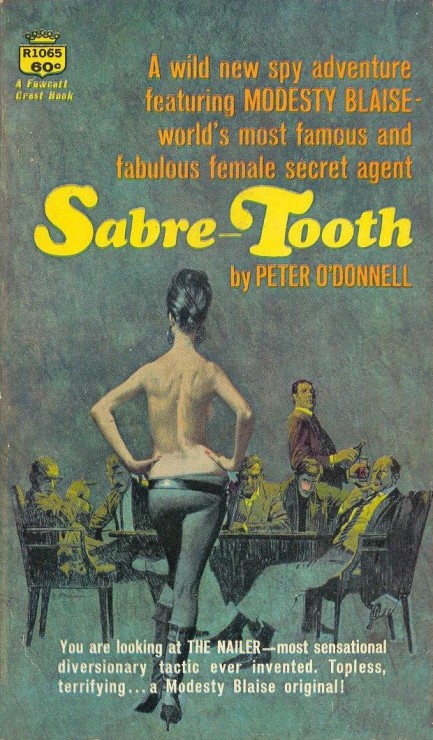| Vintage Pulp | May 22 2020 |

When an evil mastermind plans to take a bite out of the Middle East, only Modesty Blaise stands in his way.

Above you see a cover for Peter O'Donnell's Sabre-Tooth, his second Modesty Blaise novel, and as with the first book Modesty Blaise, Fawcett Publications managed to land Robert McGinnis for the cover chores. He chose a scene from the narrative in which Blaise uses “the nailer,” a move in which she walks into a room topless, and in the split seconds gained by shock and awe, proceeds to kill everyone in sight. This could only happen in an erotic style adventure, but instead of keeping things as light as the debut novel, O'Donnell veers in a darker direction. There's still plenty of waxing about his main character's physical beauty and sexual prowess, but in terms of actual plot, he takes things in a radically non-erotic direction, and in so doing attempts to show just how far Blaise will go in her pursuit of justice. We won't say what she does, or whether it's realistic, but we'll hint that if a mainstream writer did it today it would spark an online conflagration the intensity of an Australian wildfire.
One thing O'Donnell does well is villains and their henchmen. In this book the main malefactor is a brutal would-be king named Karz who plans to invade and take over Kuwait. His top henchmen are Lok and Chu. Get this: they're twins born conjoined at the shoulder. They lived much of their lives that way, grew to hate each other, but learned to fight and defend themselves in tandem as a matter of mutual survival. When they were finally separated they realized they had no purpose apart, and now go about wearing a leather harness that keeps them conjoined. They still hate each other, but also give each other purpose. As killers they fight back to back and side by side, switching configurations, baffling opponents. That entire concept is O'Donnell in full flower. Take Karz and his twin killers, add the Kuwait takeover, sprinkle in an international mercenary army holed up in an Afghan stronghold, and finally fold in equal portions of Blaise and deadly sidekick Willie Garvin, and you've got yourself a thrill ride worth reading.




































































